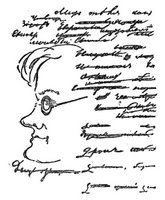RUSSIA AND PERSIA OR RUSSIA IN PERSIA? A LOOK FROM STRATFOR.COM
I have been reading the American online journal, Stratfor.com, for upwards of seven years now, and I have tended to find their articles (especially by Dr. Friedman) to be sometimes interesting and insightful. And, sometimes jejune and or sub-par. The latter suffering from ideological fixations & idee fixes on certain themes (Russia is a paper tiger, Russia is not a paper tiger and wishes to 'regain' its primacy in its old sphere of influence, the war in Iraq will be another modern day Blitz victory, et cetera, et cetera). Stratfor's strongpoints, are those of being able to bring forth obscure and or unusual information and data (the harvest one assumes of Dr. Friedman's proximity to certain elements in the American defence establishment), and, look at them from a different perspective. Dr. Friedman's article yesterday on Russia and Persia is something of this type. After reading it, one may ask oneself: is it true? Or does it make any sense? For my own part, I am extremely skeptical of the pro-offered thesis, and, think that there is much too great a reliance on variables which are not in fact related, such as the fact that some of the 'opposition' (aka Rafsanjani, et. al.) are apparently, or appear to wish to be seen to be anti-Russian. Which rather than being evidence that the Ahmadinejad and his clique are somehow or other in league with Moskva, may merely mean that the opposition may be endeavoring to cast aspertions on the nationalist bon fides of their opponents, just as the latter have on various occasions in the last ten to twelve years, indeed in the entire history of the Persian republic, accused their opponents of being in league with the Anglo-Americans and or the 'Zionists'. Et cetera. Which illustrates once again, the logical problems involved in adhering to a 'post hoc ergo propter hoc' thesis. However, with all that being said, I do find Dr. Friedman's thesis to be of great interest, and, I hereby offer it up for one and all to peruse and read.
Russia, Ahmadinejad and Iran Reconsidered, by George Friedman July 20, 2009
"At Friday prayers July 17 at Tehran University, the influential cleric and former Iranian President Ali Akbar Hashemi Rafsanjani gave his first sermon since Iran’s disputed presidential election and the subsequent demonstrations. The crowd listening to Rafsanjani inside the mosque was filled with Ahmadinejad supporters who chanted, among other things, “Death to America” and “Death to China.” Outside the university common grounds, anti-Ahmadinejad elements — many of whom were blocked by Basij militiamen and police from entering the mosque — persistently chanted “Death to Russia.”
Death to America is an old staple in Iran. Death to China had to do with the demonstrations in Xinjiang and the death of Uighurs at the hands of the Chinese. Death to Russia, however, stood out. Clearly, its use was planned before the protesters took to the streets. The meaning of this must be uncovered. To begin to do that, we must consider the political configuration in Iran at the moment.
There are two factions claiming to speak for the people. Rafsanjani represents the first faction. During his sermon, he spoke for the tradition of the founder of the Islamic republic, Ayatollah Ruhollah Khomeini, who took power during the 1979 Iranian Revolution. Rafjsanjani argued that Khomeini wanted an Islamic republic faithful to the will of the people, albeit within the confines of Islamic law. Rafsanjani argued that he was the true heir to the Islamic revolution. He added that Khomeini’s successor — the current supreme leader, Ayatollah Ali Khamenei — had violated the principles of the revolution when he accepted that Rafsanjani’s archenemy, Mahmoud Ahmadinejad, had won Iran’s recent presidential election. (There is enormous irony in foreigners describing Rafsanjani as a moderate reformer who supports greater liberalization. Though he has long cultivated this image in the West, in 30 years of public political life it is hard to see a time when has supported Western-style liberal democracy.)
The other faction is led by Ahmadinejad, who takes the position that Rafsanjani in particular — along with the generation of leaders who ascended to power during the first phase of the Islamic republic — has betrayed the Iranian people. Rather than serving the people, Ahmadinejad claims they have used their positions to become so wealthy that they dominate the Iranian economy and have made the reforms needed to revitalize the Iranian economy impossible. According to Ahmadinejad’s charges, these elements now blame Ahmadinejad for Iran’s economic failings when the root of these failings is their own corruption. Ahmadinejad claims that the recent presidential election represents a national rejection of the status quo. He adds that claims of fraud represent attempts by Rafsanjani — who he portrays as defeated presidential candidate Mir Hossein Mousavi’s sponsor — and his ilk to protect their positions from Ahmadinejad....
This debate is, of course, more complex than this. Khamenei, a key associate of Khomeini, appears to support Ahmadinejad’s position. And Ahmadinejad hardly speaks for all of the poor as he would like to claim. The lines of political disputes are never drawn as neatly as we would like. Ultimately, Rafsanjani’s opposition to the recent election did not have as much to do with concerns (valid or not) over voter fraud. It had everything to do with the fact that the outcome threatened his personal position. Which brings us back to the question of why Rafsanjani’s followers were chanting “Death to Russia?”
For months prior to the election, Ahmadinejad’s allies warned that the United States was planning a “color” revolution. Color revolutions, like the one in Ukraine, occurred widely in the former Soviet Union after its collapse, and these revolutions followed certain steps. An opposition political party was organized to mount an electoral challenge the establishment. Then, an election occurred that was either fraudulent or claimed by the opposition as having been fraudulent. Next, widespread peaceful protests against the regime (all using a national color as the symbol of the revolution) took place, followed by the collapse of the government through a variety of paths. Ultimately, the opposition — which was invariably pro-Western and particularly pro-American — took power.
Moscow openly claimed that Western intelligence agencies, particularly the CIA, organized and funded the 2004-2005 Orange Revolution in Ukraine. These agencies allegedly used nongovernmental organizations (human rights groups, pro-democracy groups, etc.) to delegitimize the existing regime, repudiate the outcome of election regardless of its validity and impose what the Russians regarded as a pro-American puppet regime. The Russians saw Ukraine’s Orange Revolution as the breakpoint in their relationship with the West, with the creation of a pro-American, pro-NATO regime in Ukraine representing a direct attack on Russian national security. The Americans argued that to the contrary, they had done nothing but facilitate a democratic movement that opposed the existing regime for its own reasons, demanding that rigged elections be repudiated.
In warning that the United States was planning a color revolution in Iran, Ahmadinejad took the Russian position. Namely, he was arguing that behind the cover of national self-determination, human rights and commitment to democratic institutions, the United States was funding an Iranian opposition movement on the order of those active in the former Soviet Union. Regardless of whether the opposition actually had more votes, this opposition movement would immediately regard an Ahmadinejad win as the result of fraud. Large demonstrations would ensue, and if left unopposed, the Islamic republic would come under threat.
In doing this, Ahmadinejad’s faction positioned itself against the actuality that such a rising would occur. If it did, Ahmadinejad could claim that the demonstrators were — wittingly or not — operating on behalf of the United States, thus delegitimizing the demonstrators. In so doing, he could discredit supporters of the demonstrators as not tough enough on the United States, a useful charge against Rafsanjani, whom the West long has held up as an Iranian moderate.
Interestingly, while demonstrations were at their height, Ahmadinejad chose to attend — albeit a day late — a multinational Shanghai Cooperation Organization conference in Moscow on the Tuesday after the election. It was very odd that he would leave Iran at the time of the greatest unrest; we assumed that he had decided to demonstrate to Iranians that he didn’t take the demonstrations seriously.
The charge that seems to be emerging on the Rafsanjani side is that Ahmadinejad’s fears of a color revolution were not simply political, but were encouraged by the Russians. It was the Russians who had been talking to Ahmadinejad and his lieutenants on a host of issues, who warned him about the possibility of a color revolution. More important, the Russians helped prepare Ahmadinejad for the unrest that would come — and given the Russian experience, how to manage it. Though we speculate here, if this theory is correct, it could explain some of the efficiency with which Ahmadinejad shut down cell phone and other communications during the postelection unrest, as he may have had Russian advisers.
Rafsanjani’s followers were not shouting “Death to Russia” without a reason, at least in their own minds. They are certainly charging that Ahmadinejad took advice from the Russians, and went to Russia in the midst of political unrest for consultations. Rafsanjani’s charge may or may not be true. Either way, there is no question that Ahmadinejad did claim that the United States was planning a color revolution in Iran. If he believed that charge, it would have been irrational not to reach out to the Russians. But whether or not the CIA was involved, the Russians might well have provided Ahmadinejad with intelligence of such a plot and helped shape his response, and thereby may have created a closer relationship with him.
How Iran’s internal struggle will work itself out remains unclear. But one dimension is shaping up: Ahmadinejad is trying to position Rafsanjani as leading a pro-American faction intent on a color revolution, while Rafsanjani is trying to position Ahmadinejad as part of a pro-Russian faction. In this argument, the claim that Ahmadinejad had some degree of advice or collaboration with the Russians is credible, just as the claim that Rafsanjani maintained some channels with the Americans is credible. And this makes an internal dispute geopolitically significant.
At the moment, Ahmadinejad appears to have the upper hand. Khamenei has certified his re-election. The crowds have dissipated; nothing even close to the numbers of the first few days have since materialized. For Ahmadinejad to lose, Rafsanjani would have to mobilize much of the clergy — many of whom are seemingly content to let Rafsanjani be the brunt of Ahmadinejad’s attacks — in return for leaving their own interests and fortunes intact. There are things that could bring Ahmadinejad down and put Rafsanjani in control, but all of them would require Khamenei to endorse social and political instability, which he will not do.
If the Russians have in fact have intervened in Iran to the extent of providing intelligence to Ahmadinejad and advice to him during his visit on how to handle the postelection unrest (as the chants suggest), then Russian influence in Iran is not surging — it has surged. In some measure, Ahmadinejad would owe his position to Russian warnings and advice. There is little gratitude in the world of international affairs, but Ahmadinejad has enemies, and the Russians would have proven their utility in helping contain those enemies.
From the Russian point of view, Ahmadinejad would be a superb asset — even if not truly under their control. His very existence focuses American attention on Iran, not on Russia. It follows, then, that Russia would have made a strategic decision to involve itself in the postelection unrest, and that for the purposes of its own negotiations with Washington, Moscow will follow through to protect the Iranian state to the extent possible. The Russians have already denied U.S. requests for assistance on Iran. But if Moscow has intervened in Iran to help safeguard Ahmadinejad’s position, then the potential increases for Russia to provide Iran with the S-300 strategic air defense systems that it has been dangling in front of Tehran for more than a decade.
If the United States perceives an entente between Moscow and Tehran emerging, then the entire dynamic of the region shifts and the United States must change its game. The threat to Washington’s interests becomes more intense as the potential of a Russian S-300 sale to Iran increases, and the need to disrupt the Russian-Iranian entente would become all the more important. U.S. influence in Iran already has declined substantially, and Ahmadinejad is more distrustful and hostile than ever of the United States after having to deal with the postelection unrest. If a Russian-Iranian entente emerges out of all this — which at the moment is merely a possibility, not an imminent reality — then the United States would have some serious strategic problems on its hands.
For the past few years, STRATFOR has assumed that a U.S. or Israeli strike on Iran was unlikely. Iran was not as advanced in its nuclear program as some claimed, and the complexities of any attack were greater than assumed. The threat of an attack was thus a U.S. bargaining chip, much as Iran’s nuclear program itself was an Iranian bargaining chip for use in achieving Tehran’s objectives in Iraq and the wider region. To this point, our net assessment has been accurate.
At this point, however, we need to stop and reconsider. If Iran and Russia begin serious cooperation, Washington’s existing dilemma with Iran’s nuclear ambitions and its ongoing standoff with the Russians would fuse to become a single, integrated problem. This is something the United States would find difficult to manage. Washington’s primary goal would become preventing this from happening.
Ahmadinejad has long argued that the United States was never about to attack Iran, and that charges by Rafsanjani and others that he has pursued a reckless foreign policy were groundless. But with the “Death to Russia” chants and signaling of increased Russian support for Iran, the United States may begin to reconsider its approach to the region.
Iran’s clerical elite does not want to go to war. They therefore can only view with alarm the recent ostentatious transiting of the Suez Canal into the Red Sea by Israeli submarines and corvettes. This transiting did not happen without U.S. approval. Moreover, in spite of U.S. opposition to expanded Israeli settlements and Israeli refusals to comply with this opposition, U.S. Secretary of Defense Robert Gates will be visiting Israel in two weeks. The Israelis have said that there must be a deadline on negotiations with Iran over the nuclear program when the next G-8 meeting takes place in September; a deadline that the G-8 has already approved. The consequences if Iran ignores the deadline were left open-ended....
All of this assumes that there is substance behind a mob chanting “Death to Russia.” There appears to be, but of course, Ahmadinejad’s enemies would want to magnify that substance to its limits and beyond. This is why we are not ready to simply abandon our previous net assessment of Iran, even though it is definitely time to rethink it".











0 Comments:
Post a Comment
<< Home